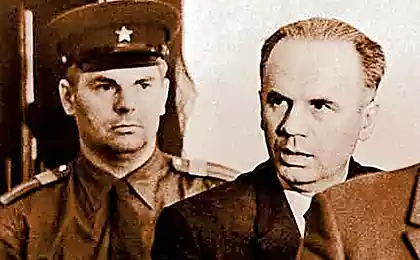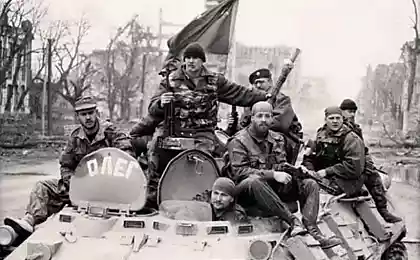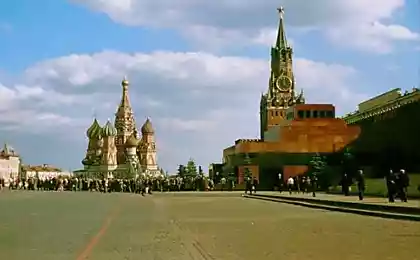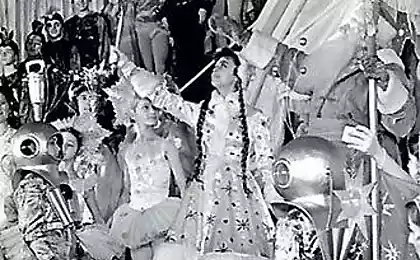756
As the Soviet Union helped Vietnam
On the eve of the war in Afghanistan, the Soviet Union had to take part in yet another conflict. At the beginning of 1979 there was a clash between China and Vietnam, and thanks to the Soviet Union managed to avoid large-scale military action.
With the coming to power of Deng Xiaoping, the relationship between China and Vietnam have become more strained. The conclusion of the Soviet-Vietnamese treaty of friendship and cooperation 3 November 1978 further intensified the friction between Beijing and Hanoi. In it approves the regulations of the "joint defense" of "joint actions to ensure the security of both countries", as well as the obligation to exchange views on major international issues, as they relate to the parties of the agreement. Beijing withdrew its ambassador from Hanoi and the military attache, reduce the size of representation, interrupted railway traffic between the two countries and discontinued economic aid. The Chinese are hoping to control Vietnam with the help of neighboring Kampuchea (modern Cambodia), where at that time flourished the Khmer Rouge regime led by Pol Pot. But the dictator does not justify the hopes of China: massacred, he spared no one, including the Vietnamese community. In December 1978 Viet Nam decided to intervene and support the rebel army. January 7, 1979 Pol Pot's regime, China's only ally in the region, was overthrown, which caused strong resentment of Beijing.
Will 5 pictures and text.
Source
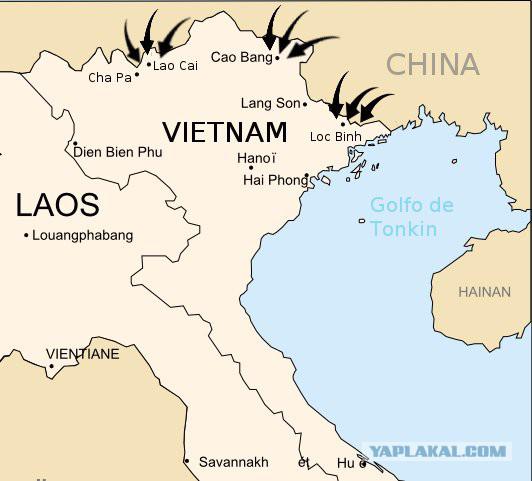
In late January, Deng Xiaoping came to the US with a nine-day visit in Washington, he said that Vietnam must "teach a lesson". By February, the leader of China's military forces have pulled together to the border with Vietnam. Total on the front was deployed 29 divisions, in addition, conducted covert relocation of aviation. February 16, 1979 Hanoi was formally charged with the threat of Chinese territory, and at dawn on February 17 People's Liberation Army (PLA) invaded the northern provinces of Vietnam.
Deng Xiaoping's government pursued several goals: to undermine the enemy's defenses, causing economic losses and seize territory with the provincial centers of Lao Cai, Cao Bang and Lang Son. But the main objective was the approval of control over the region. The outbreak of war with Vietnam, China challenged the Soviet Union. The formal reason was the oppression of the Chinese community in Vietnam. Chinese first deprived of Vietnamese nationality, then took away the right to have their own business and to hold any political office. In large cities, the Chinese trade is closed and the product was subjected to confiscation. Chinese living on the border, just kicked out into Chinese territory. The second, more formal reason was the invasion of Vietnamese naval vessels in the Spratly Islands, which China considers its territory.
PLA launched an attack across the Vietnam-China border. The main directions of the invasion were Laokayskoe, Kaobangskoe and Langshonskoe. The number of the Chinese army, focusing on the Vietnamese border, reached 600 thousand soldiers, but the country has come about with the support of 250 thousand 200 tanks. They were opposed by the Vietnamese people's army of about 100,000 soldiers.
As soon as the Soviet Union learned of the attack China, Vietnam was directed chief military adviser in Laos Major General Gaponenko. The Soviet Union launched a full-scale preparations for possible military action. 6 military districts were put on alert. East sent two airborne divisions, which are located on the border with Mongolia. February 19, 1979 in Hanoi, arrived Army General Gennady Obaturov appointed chief military adviser in Vietnam. Together with other Soviet experts, he studied the situation and advised the Vietnamese commanders mobilized army troops on Langshonskoe direction. Contributed to the victory and a few Soviet specialists. Pilots transport squadrons on the An-12 was carried out transfer of the Army Corps of Kampuchea on Langshonskoe direction, communications node communications chief military adviser (about 120 people were there in August of 1978, and 68 were transferred after the start of the conflict) provides a link of our advisers, including in the war zone.
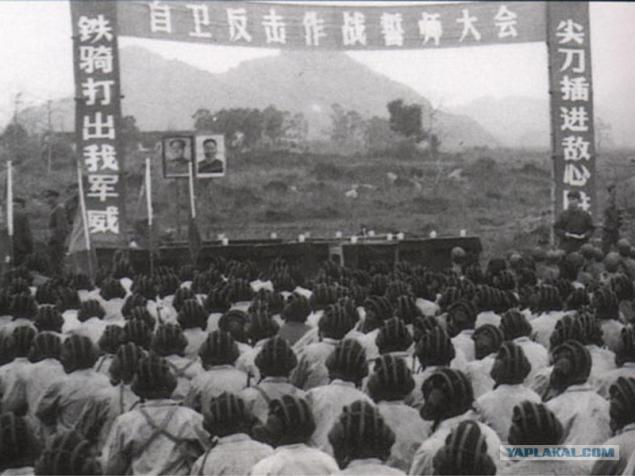
Completely by parts brought in from the Soviet Union, it has solved the problem of aerial reconnaissance of the enemy in Vietnam. Parts of military transport aircraft provided air transportation in the territory of Vietnam. Successfully operated an air bridge between the Soviet Union and Vietnam. As part of the exercise equipment and supplies Vietnam aircraft military transport aircraft in less than a month it has been transported more than 20 thousand. Man personnel, more than 1,000 pieces of equipment, 20 aircraft and helicopters, more than 3 thousand. Tons of weapons, equipment and ammunition.
It turned out to be a serious and military aid to Vietnam by sharply increasing its military capabilities through the supply of equipment and weapons. In the period from the beginning of the conflict until the end of March by sea it was transferred more than 400 tanks, infantry fighting vehicles and armored personnel carriers, 400 artillery pieces and mortars, 50 MLRS "Grad", more than 100 anti-aircraft installations, 400 portable air defense systems and thousands of missiles for them, more than 800 hand-held antitank grenade launchers, 20 fighters. In addition, it provides special engineering equipment for repair armor and automotive equipment and weapons. All this huge amount of equipment and weapons was isolated and put Vietnam in almost one month.
Scientists have begun to mobilization and bringing troops and naval forces in full combat readiness. Because the stock was designed more than 52 thousand. People. of assigned staff and supplied from the national economy more than 5 thousand. cars. The largest were military exercises in Mongolia, which was attended by six mechanized infantry and armored divisions, three of them additionally introduced into Mongolia from Siberia and Trans-Baikal. In addition, the activities in the territory of the republic were involved two teams of up to three air divisions and units and amplification.

In addition, during this period it carried out military exercises in the Far East and East Kazakhstan with the participation therein of several combined-arms and air connections, as well as border troops. The exercise was carried out combat coordination troops. Connections and parts in difficult climatic and natural conditions to march long distances from Siberia to Mongolia (more than 2 thousand km.). The troops regrouped by rail, airlift. In particular, the Airborne Division of the Tula region moved to Chita 5, 5 thous. Km of military transport aircraft the same flight in just two days. Shelves combat aircraft from the territory of Ukraine and Belarus were transferred to airfields Mongolia.
In the border areas with China perfected the organization of defense, repel the invasion of the enemy, and organizing a counterattack counterattacks.
There was also mobilized the Pacific Fleet. At the end of February in the South China Sea were 13 warships, and in March - already 30 ships. In addition, the submarine in the Gulf of Tonkin blocked access for warships of other states. Connection Soviet ships were in the South China Sea until April 1979. The result of their actions was the fact that the South Navy China did not participate in the attack, despite the fact that totaled 300 ships, although most of them were small coastal defense ships. In addition, they provide safe passage and delivery of goods to Vietnam, as during the fighting in the port of Haiphong, which was in the 100-250 kilometers from the front line, were under Soviet ships unloading 5-6 who delivered military equipment, including missiles and radars. For courage and heroism in the performance of the task, 36 sailors of the squadron of the Pacific Fleet were awarded government awards.
The important role played by the psychological factor. The Chinese Embassy in Moscow sent home by train and on the way to the east they could see columns of tanks moving towards the border. In Mongolian-Chinese border in the Gobi desert, were also held exercises paratroopers from the 106th Guards Airborne Division.
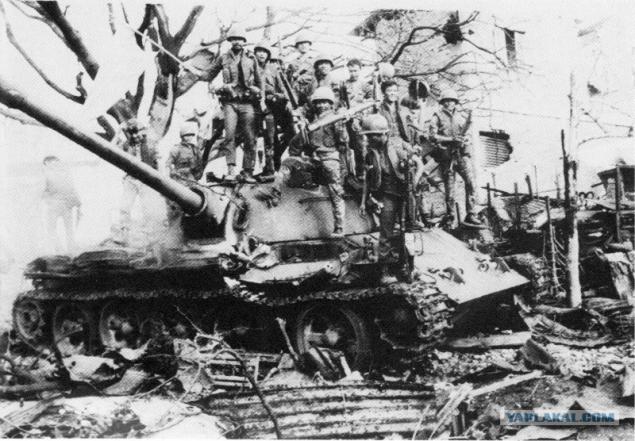
Chinese army commanded by General Yang Dezhi. In late February - early March, he mobilized the army reserves, and the troops were able to capture the main provincial centers. February 18 PLA took Lao Cai, March 2 - Cao Bang, Lang Son March 4 fell. Road to Hanoi was open. However, in other areas of the Chinese army plagued with failures, and soon she was pushed back. In response to the aggression of Vietnam sent a protest to the United Nations, however, without interrupting diplomatic relations with China. The Soviet Union and Taiwan have accused the US of supporting the PRC.
March 2 The Soviet Union issued a statement in which it was clearly stated that if China does not withdraw its troops from Vietnam, he will have to fight on two fronts. The day after the capture of Lang Son on 5 March, the Vietnamese authorities have declared a general mobilization. At the same time, Beijing officially announced the termination of the offense and the departure of the Chinese army in Vietnam. This decision was due to a number of political and military factors, the main ones are: solid and strong support Hanoi from Moscow, demanded the immediate cessation of aggression; preparation for and conduct of military actions by the Soviet Union in the East; strengthening of dissent within the Peking leadership during the conflict; negative international reaction; stubborn resistance forces Vietnam People's Army, which inflicted heavy losses to the aggressor; manifested serious shortcomings in the operational-tactical training command staff of the Chinese troops, equipped with modern weapons and equipment, difficulties in the supply. Waste of the main forces of the Chinese in all fields preceded by strong artillery fire and air raids demonstrative attacks covering forces retreat. If widely applied in waste massive barrage of artillery and mortar fire, mined roads, collapsed bridges, destroyed economic objects. Finally, the troops left the country by the end of March.
Thus, Vietnamese-Chinese conflict lasted only 30 days and ended with the victory of Vietnam. According to current data, the human losses on both sides totaled 22 thousand killed and wounded Chinese and about 20 thousand killed and wounded Vietnamese. Seriously affected northern provinces of Vietnam, which was inflicted enormous economic damage. It destroyed more than 45,000 homes of civilians, about 1,000 schools, 400 hospitals and 55 industrial enterprises. The conflict wore land character, the two sides have not used any aircraft or Navy. During the confrontation revealed shortcomings armies of both parties, that the impetus for the modernization of the Chinese army.
Author Romakhin Maria
ALL.
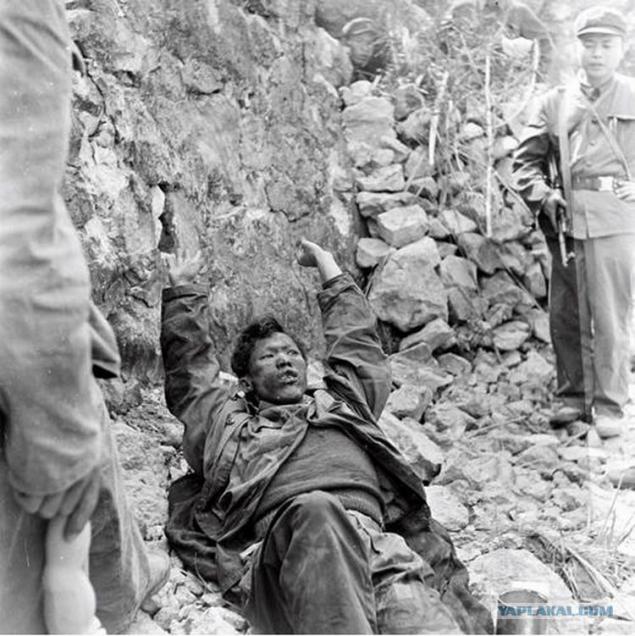
Source:
With the coming to power of Deng Xiaoping, the relationship between China and Vietnam have become more strained. The conclusion of the Soviet-Vietnamese treaty of friendship and cooperation 3 November 1978 further intensified the friction between Beijing and Hanoi. In it approves the regulations of the "joint defense" of "joint actions to ensure the security of both countries", as well as the obligation to exchange views on major international issues, as they relate to the parties of the agreement. Beijing withdrew its ambassador from Hanoi and the military attache, reduce the size of representation, interrupted railway traffic between the two countries and discontinued economic aid. The Chinese are hoping to control Vietnam with the help of neighboring Kampuchea (modern Cambodia), where at that time flourished the Khmer Rouge regime led by Pol Pot. But the dictator does not justify the hopes of China: massacred, he spared no one, including the Vietnamese community. In December 1978 Viet Nam decided to intervene and support the rebel army. January 7, 1979 Pol Pot's regime, China's only ally in the region, was overthrown, which caused strong resentment of Beijing.
Will 5 pictures and text.
Source

In late January, Deng Xiaoping came to the US with a nine-day visit in Washington, he said that Vietnam must "teach a lesson". By February, the leader of China's military forces have pulled together to the border with Vietnam. Total on the front was deployed 29 divisions, in addition, conducted covert relocation of aviation. February 16, 1979 Hanoi was formally charged with the threat of Chinese territory, and at dawn on February 17 People's Liberation Army (PLA) invaded the northern provinces of Vietnam.
Deng Xiaoping's government pursued several goals: to undermine the enemy's defenses, causing economic losses and seize territory with the provincial centers of Lao Cai, Cao Bang and Lang Son. But the main objective was the approval of control over the region. The outbreak of war with Vietnam, China challenged the Soviet Union. The formal reason was the oppression of the Chinese community in Vietnam. Chinese first deprived of Vietnamese nationality, then took away the right to have their own business and to hold any political office. In large cities, the Chinese trade is closed and the product was subjected to confiscation. Chinese living on the border, just kicked out into Chinese territory. The second, more formal reason was the invasion of Vietnamese naval vessels in the Spratly Islands, which China considers its territory.
PLA launched an attack across the Vietnam-China border. The main directions of the invasion were Laokayskoe, Kaobangskoe and Langshonskoe. The number of the Chinese army, focusing on the Vietnamese border, reached 600 thousand soldiers, but the country has come about with the support of 250 thousand 200 tanks. They were opposed by the Vietnamese people's army of about 100,000 soldiers.
As soon as the Soviet Union learned of the attack China, Vietnam was directed chief military adviser in Laos Major General Gaponenko. The Soviet Union launched a full-scale preparations for possible military action. 6 military districts were put on alert. East sent two airborne divisions, which are located on the border with Mongolia. February 19, 1979 in Hanoi, arrived Army General Gennady Obaturov appointed chief military adviser in Vietnam. Together with other Soviet experts, he studied the situation and advised the Vietnamese commanders mobilized army troops on Langshonskoe direction. Contributed to the victory and a few Soviet specialists. Pilots transport squadrons on the An-12 was carried out transfer of the Army Corps of Kampuchea on Langshonskoe direction, communications node communications chief military adviser (about 120 people were there in August of 1978, and 68 were transferred after the start of the conflict) provides a link of our advisers, including in the war zone.

Completely by parts brought in from the Soviet Union, it has solved the problem of aerial reconnaissance of the enemy in Vietnam. Parts of military transport aircraft provided air transportation in the territory of Vietnam. Successfully operated an air bridge between the Soviet Union and Vietnam. As part of the exercise equipment and supplies Vietnam aircraft military transport aircraft in less than a month it has been transported more than 20 thousand. Man personnel, more than 1,000 pieces of equipment, 20 aircraft and helicopters, more than 3 thousand. Tons of weapons, equipment and ammunition.
It turned out to be a serious and military aid to Vietnam by sharply increasing its military capabilities through the supply of equipment and weapons. In the period from the beginning of the conflict until the end of March by sea it was transferred more than 400 tanks, infantry fighting vehicles and armored personnel carriers, 400 artillery pieces and mortars, 50 MLRS "Grad", more than 100 anti-aircraft installations, 400 portable air defense systems and thousands of missiles for them, more than 800 hand-held antitank grenade launchers, 20 fighters. In addition, it provides special engineering equipment for repair armor and automotive equipment and weapons. All this huge amount of equipment and weapons was isolated and put Vietnam in almost one month.
Scientists have begun to mobilization and bringing troops and naval forces in full combat readiness. Because the stock was designed more than 52 thousand. People. of assigned staff and supplied from the national economy more than 5 thousand. cars. The largest were military exercises in Mongolia, which was attended by six mechanized infantry and armored divisions, three of them additionally introduced into Mongolia from Siberia and Trans-Baikal. In addition, the activities in the territory of the republic were involved two teams of up to three air divisions and units and amplification.

In addition, during this period it carried out military exercises in the Far East and East Kazakhstan with the participation therein of several combined-arms and air connections, as well as border troops. The exercise was carried out combat coordination troops. Connections and parts in difficult climatic and natural conditions to march long distances from Siberia to Mongolia (more than 2 thousand km.). The troops regrouped by rail, airlift. In particular, the Airborne Division of the Tula region moved to Chita 5, 5 thous. Km of military transport aircraft the same flight in just two days. Shelves combat aircraft from the territory of Ukraine and Belarus were transferred to airfields Mongolia.
In the border areas with China perfected the organization of defense, repel the invasion of the enemy, and organizing a counterattack counterattacks.
There was also mobilized the Pacific Fleet. At the end of February in the South China Sea were 13 warships, and in March - already 30 ships. In addition, the submarine in the Gulf of Tonkin blocked access for warships of other states. Connection Soviet ships were in the South China Sea until April 1979. The result of their actions was the fact that the South Navy China did not participate in the attack, despite the fact that totaled 300 ships, although most of them were small coastal defense ships. In addition, they provide safe passage and delivery of goods to Vietnam, as during the fighting in the port of Haiphong, which was in the 100-250 kilometers from the front line, were under Soviet ships unloading 5-6 who delivered military equipment, including missiles and radars. For courage and heroism in the performance of the task, 36 sailors of the squadron of the Pacific Fleet were awarded government awards.
The important role played by the psychological factor. The Chinese Embassy in Moscow sent home by train and on the way to the east they could see columns of tanks moving towards the border. In Mongolian-Chinese border in the Gobi desert, were also held exercises paratroopers from the 106th Guards Airborne Division.

Chinese army commanded by General Yang Dezhi. In late February - early March, he mobilized the army reserves, and the troops were able to capture the main provincial centers. February 18 PLA took Lao Cai, March 2 - Cao Bang, Lang Son March 4 fell. Road to Hanoi was open. However, in other areas of the Chinese army plagued with failures, and soon she was pushed back. In response to the aggression of Vietnam sent a protest to the United Nations, however, without interrupting diplomatic relations with China. The Soviet Union and Taiwan have accused the US of supporting the PRC.
March 2 The Soviet Union issued a statement in which it was clearly stated that if China does not withdraw its troops from Vietnam, he will have to fight on two fronts. The day after the capture of Lang Son on 5 March, the Vietnamese authorities have declared a general mobilization. At the same time, Beijing officially announced the termination of the offense and the departure of the Chinese army in Vietnam. This decision was due to a number of political and military factors, the main ones are: solid and strong support Hanoi from Moscow, demanded the immediate cessation of aggression; preparation for and conduct of military actions by the Soviet Union in the East; strengthening of dissent within the Peking leadership during the conflict; negative international reaction; stubborn resistance forces Vietnam People's Army, which inflicted heavy losses to the aggressor; manifested serious shortcomings in the operational-tactical training command staff of the Chinese troops, equipped with modern weapons and equipment, difficulties in the supply. Waste of the main forces of the Chinese in all fields preceded by strong artillery fire and air raids demonstrative attacks covering forces retreat. If widely applied in waste massive barrage of artillery and mortar fire, mined roads, collapsed bridges, destroyed economic objects. Finally, the troops left the country by the end of March.
Thus, Vietnamese-Chinese conflict lasted only 30 days and ended with the victory of Vietnam. According to current data, the human losses on both sides totaled 22 thousand killed and wounded Chinese and about 20 thousand killed and wounded Vietnamese. Seriously affected northern provinces of Vietnam, which was inflicted enormous economic damage. It destroyed more than 45,000 homes of civilians, about 1,000 schools, 400 hospitals and 55 industrial enterprises. The conflict wore land character, the two sides have not used any aircraft or Navy. During the confrontation revealed shortcomings armies of both parties, that the impetus for the modernization of the Chinese army.
Author Romakhin Maria
ALL.

Source:














